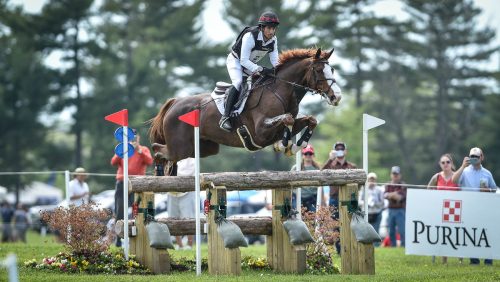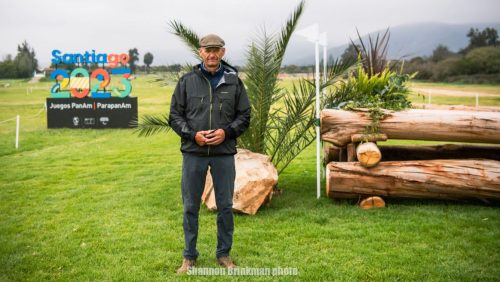Elkton, Md.—Oct. 20
For the past two years, course designer Ian Stark has heard about how it was too easy for riders to make time at the Mars Maryland 5 Star at Fair Hill. In 2021, 11 of 42 made the time, and last year 13 of 24 finished double clear. So this year Stark focused on slowing the riders while still keeping a forward, bold five-star track with an optimum time of 11 minutes, 10 seconds.
“In my defense, the first year was the first time we had the competition and I was getting to know the ground,” he said. “Second year was like a first year again because the start and finish was in a different place—but that’s my excuse. This year my attitude is ‘Be careful what you wish for,’ so I have slowed them down, I hope.”
Great Britain’s Piggy March, who is leading after Day 1 of dressage, crossed the ocean with her five-star first-timer Brookfield Cavalier Cruise, thinking it’d be a good run and easier than Burghley [England], which she says is the hardest five-star she’s done.
“I get here, and the further I get round, I’m like, ‘Oh God, I should’ve gone to Burghley and just gone a bit slower,’ ” she said. “I paid all this money and come all this way just to be absolutely terrified and think, what am I doing?
“I’ve grown up watching Ian Stark, and I’ve grown up riding a lot of Ian Stark’s courses, so we’ve learned over the years what we do expect, and we do have a lot of trust in him as well,” she added. “He’s a very bold cross-country rider himself, and he builds bold courses, so it rewards brave riding, and it’s usually always very clear for a horse to see a question. It is just big all the way, but it really gets you into the course.
March commented on the throwback feel of the fences Stark has put on the course, like “a real old-fashioned Sunken Road fence.”
“It’s just a really good jumping effort for both horse and rider, and we don’t see a lot [of those],” she said. “We don’t see a lot of these old-fashioned type fences—he’s got a Vicarage Vee type fence over the ditch, which I remember watching very clearly him on Murphy Himself over things like that. We’ve not seen it for all these years, so suddenly you get there and think, ‘Oh my God.’
“But he’s very clever; he knows,” she continued. “I’m hoping, by that stage in the course, that the horses have got very much into their rhythm and got a bit more jump and just think it’s another jump and stay brave. As long as they’re confident, then all these fences should still ride well. But it’s a real rider-frightener course, and we’ve just got to go out there and do good jobs, but it will reward good, brave riding and good, honest horses.”
Leaving the start box, competitors will have two fences to get them going, the first on an uphill approach and the second on a slight downhill, before meeting their first combination—and first water jump—at 3AB, the Maryland Sports Commission Splash, a pair of skinny tables on either side of a water. The riders did request that the back of the A element be raised so the horses could see that it was a spread fence a bit sooner.
Then they’ll have another gallop fence before heading up to the arena, where there’s a pair of brush oxers to a skinny wedge at 5ABC, the Kelso Question.
“They’re going to be thinking about the time this year, so the tighter they go, the better it is for them, but then it’s a bit risky,” Stark said. “Just two oxers to this skinny there. The good ones will go three and three [strides]; there might be a four and four or a four and three or a three and four, whatever the horses are ready for.”
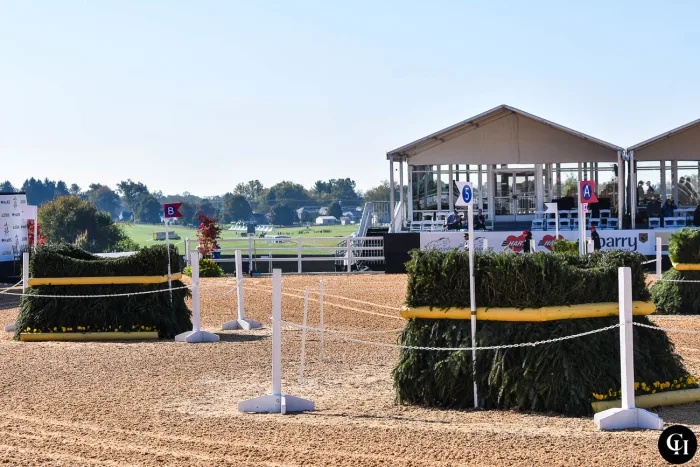
Their first question once they exit the arena is a pair of frangible timber fences set two strides apart downhill on a slight angle, which will slow the riders down to get a good jump.
The course features a lot of right-hand turns to left-hand turns (and vise versa) before and after the fences, which will slow the horses as they balance, and riders will see that before the next combination.
ADVERTISEMENT
Stark’s added an old-fashioned sunken road this year at 7ABCD. The horses will jump over a log, bounce down into the sunken road, then take a stride across the bottom before they jump back up a bank to another log.
“I deliberately made them chunky logs here,” he said. “I didn’t want a frangible device here because I think a bounce into the sunken road, horses slow themselves down with their back feet, and I didn’t want riders getting 11 penalties by horses do what they do naturally.
“Riders are kind of out of the habit of riding sunken roads,” Stark added. “I kind gave some of them the heads up earlier this year by putting sunken roads in in different places, and said if you’re going to Fair Hill, you kind of ought to be here, and also the same with the bounce into water. I’ve done that at different places this year, and I didn’t tell the riders, but to try and sort of let them get the feel of it. I did do a bounce into water at Bramham [England] with a big drop, so the Brits had to be my guinea pigs to find out how well it worked.”
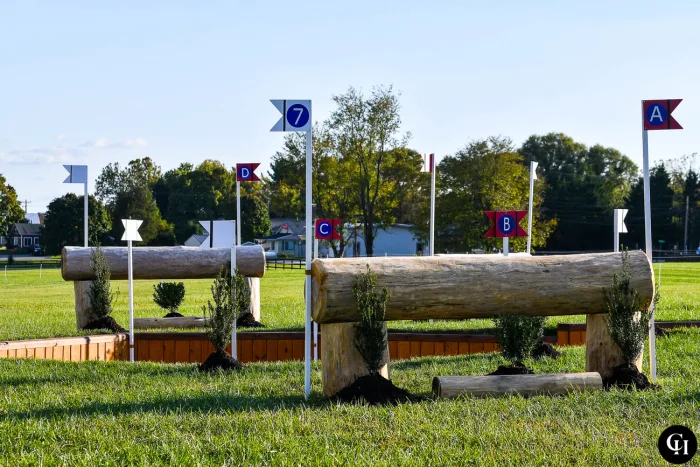
The second water come at Fences 9 and 10AB, the Brown Advisory Chesapeake Bay Canoe and C&D Canal Barges. They’ll drop down over a upturned canoe with water streaming out of it, which Stark said horses are now used to. One rider did request an alternate there, so he’s added another jump in without the water element, but taking this option will take up valuable time.
A friendly ditch-and-brush followed by an open oxer, will take competitors into a hay field. Their next combination, the MagnaWave Hollow at 13ABC, starts over a big “wave” rolltop down the hill to a righthand turn to skinny hanging log and righthand brush shoulder. Stark warned against jumping too big at the first element.
“It’s encouraging galloping and a big jump, but the quick way is they’ve got to turn on the landing pretty soon and up the steep bank to that skinny on the top. So they need to jump that wave in more of a show jumping frame of mind and land steady. If they’re out of control, they’ve got a long way, but it’s a massive circle, jumping the long B and C.
“A couple of the riders asked me how many strides it would be from the wave to that skinny on the top, and I said I have no idea,” he added. “It’s not a fence you can count strides. You’ve kind of got to react. Jump the big wave, bring them back, turn, welly on up to that skinny. You don’t know how they’re going take off or where they’re going to take off. You don’t know how they’re going to land. You’ve then got to be in balance and be ready for the brush down the hill. There I’m expecting clever footwork from the horses.”
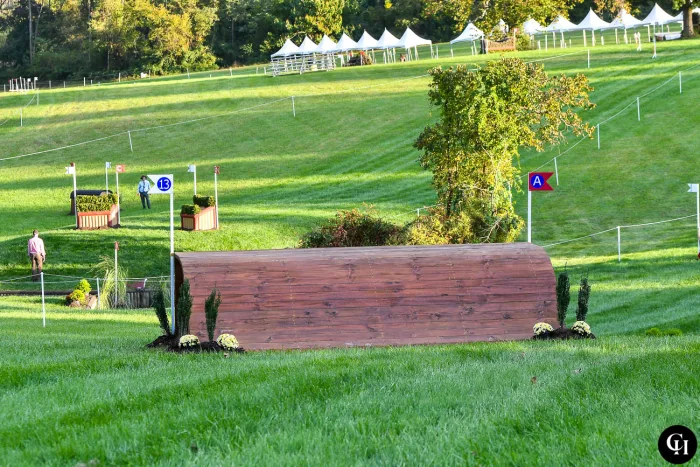
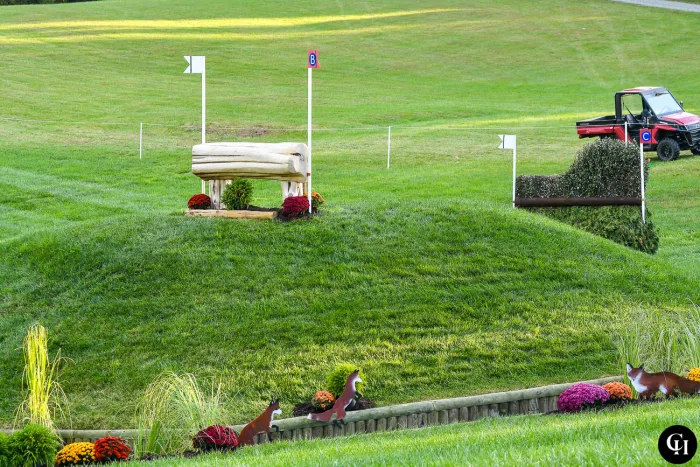
Another combination, the Select Event Group Baltimore Barricades at 14AB, follows soon after. It’s meant to be a galloping question, but the proximity of the tailgating spots to the roping means riders will have to keep their horses focused. It’s a committed four strides before turning three strides to Fence 15, a brush corner. The corner is numbered separately, so if riders need to, they can circle after the barricades without picking up 20 penalties.
A long gallop up the hill comes next with a pair of friendly fences bring them into Sawmill Field, which features the Cecil County Corners at 18/19AB. There’s a long route here too, but taking it will eat up time. Riders will jump a righthand open corner at 18 to a lefthand open corner at 19A before cantering up a mound to jump a skinny at 19B.
One more galloping fence brings them to the Mars Equestrian Crab Water, which jumps in the opposite direction from last year. Here’s where riders will see the bounce Stark spoke of—they’ll bounce over a log to the crab drop at 21ABC. The crab is closer to the takeoff point and lower than in previous years to account for the bounce in.
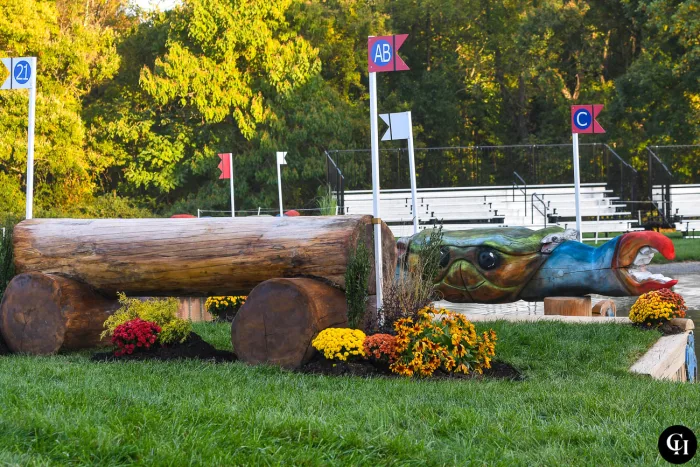
They’ll then gallop across the water to jump up a Normandy Bank at 22A, over a righthand brush shoulder at the top of the bank and downhill in two committed strides to a lefthand brush shoulder.
“One of the riders I met [Wednesday] said ‘This is really tight.’ I went ‘What are you riding?’ I thought they were on Pegasus because they thought it was a short distance on two strides,” Stark said. “He did say his horse had a massive stride. So he said he’s gonna have to jump the first brush and hang on tight. I think most of them will be [kicking] down there.”
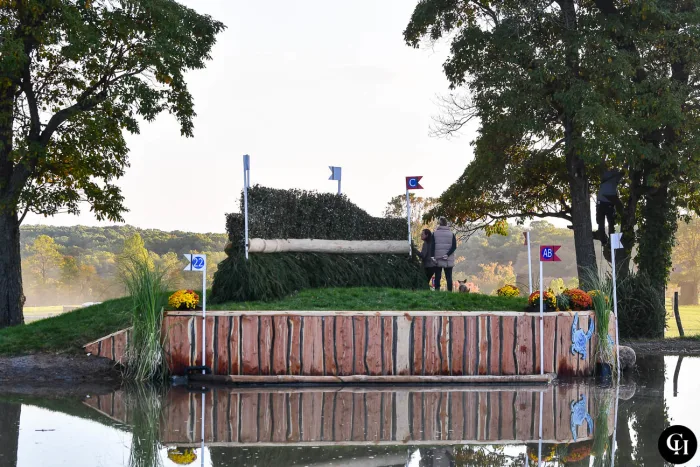
While there’s no alternate to the second brush if they take the direct route, there is space to pull left if they’re disorganized after the step up and first brush to give themselves room without crossing their tracks.
ADVERTISEMENT
Riders will have another straightforward hanging log before 24, the imposing Foxcatcher Ditch, which they’ve dubbed “the butterfly.”
“I keep saying to the riders, when you’re on the flat and you’re four strides away, then it’s obvious,” he said. “It’s not that scary. It’s only [scary] when you stand at the edge and look at it for five minutes—and hopefully the horses aren’t going to do that. I think, for me, it should ride really well, I think, because of the takeoff. It sort of puts them into the middle and so the skinny bit to skinny bit they’re kind of channeled into it. As long as the riders have got the horse taking them, as long as they’re not off the bridle or a bit slow, I think that will jump really well.”
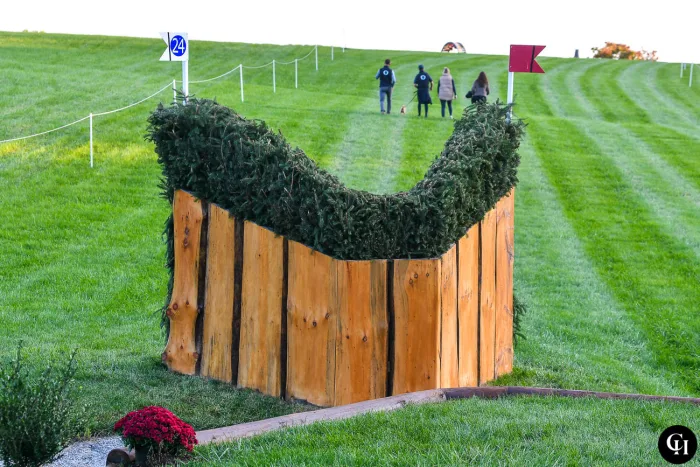
They’ll gallop up the hill to the Fair Hill International Rollercoaster and Drop at 25ABCD. They’ll once again jump through the roller coaster keyhole, drop down off the signature Fair Hill bank before jumping a house to a skinny on the right. If they need it, there’s another house to the left, but Stark’s made it such that doing so will require them to circle around the wrong way before heading back down the hill.
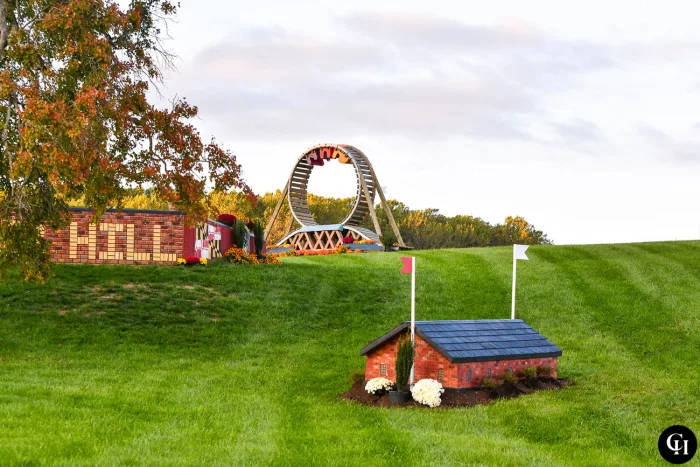
A massive oak table meets them at the bottom of the hill. This is another place he’s forced the riders to slow down a bit, as they won’t be able to take it as a fly fence.
The final combination on course is a pair of open oxers, both of which are frangible. Stark said his decision to put a frangible combination at the end of a course came from the annual year-end meeting five-star course designers have in Amsterdam with a few cross-country coaches and riders to discuss how things went that year.
“The riders had gone to [British coach] Dickie Waygood and said that they know that frangible fences are here to stay and they think frangible fences at the end of the course are the right place for them because it makes them slow down and be more accurate. Hence, the penultimate fence is a double of open oxers, frangible,” he said. “They’re not difficult, but they need to keep the petrol in the tank, and they need to be accurate.”
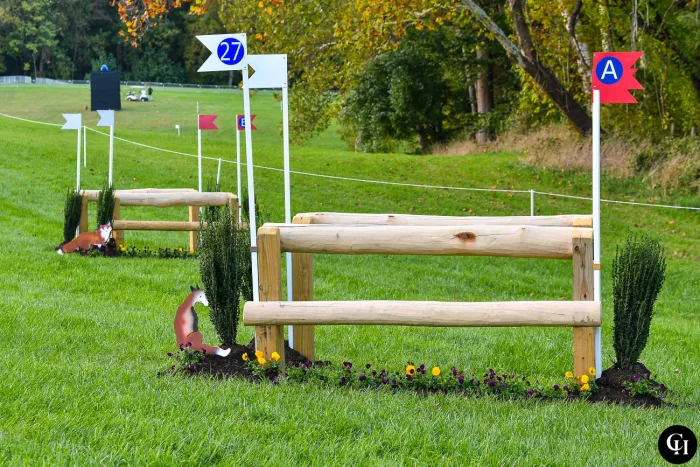
In an unusual choice, the final fence will be a brush rolltop in water before a short gallop up a hill to the finish flags.
“I’ve been expecting to be attacked by the riders, and they’ve all said, ‘No, we think it’s a good idea,’ ” he said. “But again, they can’t gallop; they can’t wing it. They’ve got to go balanced down into the water and pop it. What you don’t want is a tired horse here. The riders have to be thinking right from the word ‘go’ of what they’re going to have left in the tank at the end.”
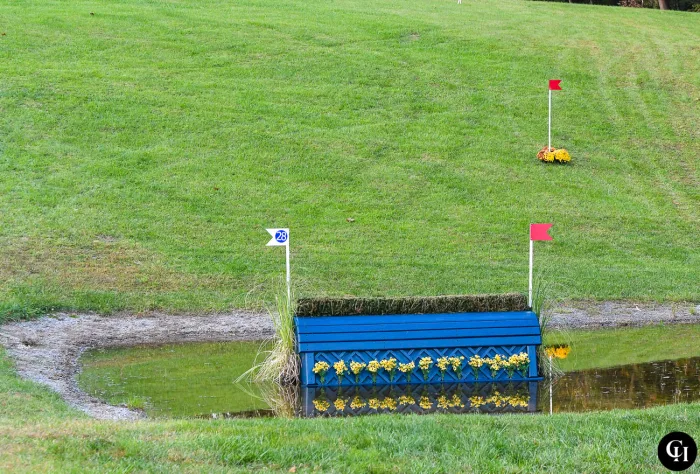
See the whole course with options here.
The Chronicle will be on-site to bring you everything you need to know at coth.com, so you don’t have to miss a minute of the action. You can find all our coverage of the event in one spot, and you also can follow us on Instagram and Facebook. You can read more in-depth coverage in the Nov. 27 issue of the Chronicle.
Follow all of our coverage here.










































